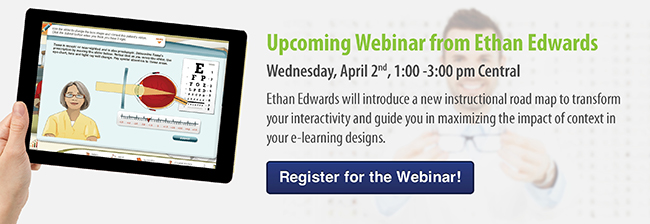Blog
Pillar I for Transformative e-Learning Instructional Design: Context
By Ethan Edwards, chief instructional strategist | @ethanaedwards


Unlocking The Power of CONTEXT in e-Learning Design
By Ethan Edwards | March 05, 2014 | Custom Learning | 0 Comments
 By Ethan Edwards, chief instructional strategist | @ethanaedwards
By Ethan Edwards, chief instructional strategist | @ethanaedwards
con·text
känˌtekst/
noun
1. the circumstances that form the setting for an event, statement, or idea, and in terms of which it can be fully understood and assessed.
Such a simple word.
Yet how powerful it can be in creating e-learning that works. Context is a critical component of our CCAF-based Model (Context-Challenge-Activity-Feedback) for instructional interactivity created by Michael Allen. Of course, all learning takes place in some context. But I’m afraid its very ordinariness causes context to be largely overlooked in how critical it is to designing a good interaction.
There is always context, whether you design one or not. Even the blandest context-free content presentation becomes the context, albeit a boring one, for the learner. Too often I see traditional contexts used largely by default or habit, when in truth, the design of the context is every bit as important as imagining the other aspects of interactivity.
Context can:
- be completely visual, establishing relevance by creating an environment of meaning in which the lesson activities reside
- be narrative in nature, letting story elements create interest, suspense, recognition, etc.
- bring emotion, representing human feelings and identities through media and personality to create a bond with the learner
- provide structure in a way that encourages practice and repetition that might be otherwise difficult to achieve
- create a gaming environment that enhances motivation and entertainment while also achieving some of the aforementioned possibilities
But how do you come up with the right context? First off, there is no single right context. There are many great contexts for a particular challenge, and there are also many poor ones—the key to coming up with a powerful context comes from what you learn from analysis:
- What are the desired performance outcomes?
- What is the performance environment like?
- What are the conditions for success?
- What kinds of errors get in the way of learner success?
If these are the kinds of design questions you struggle with, I invite you to join me for a two-hour webinar, Unlocking the Power of CONTEXT in e-Learning Design, on Wednesday, April 2nd, for an in-depth look at creating context in your e-learning. I’ll guide participants through designing context and taking full advantage of its role in creating effective interactions. We’ll explore in more detail the various ways it can create immediate meaning and value in your e-learning courses. I’ll introduce The CCAF Context Design Matrix for e-Learning to assist you in making context-related design choices on a day-to-day basis when setting out to create future e-learning projects. Finally, we'll look at some real-world e-learning examples to see how this thinking results in stellar e-learning.
Registration information can be found here. I hope you’ll join me!
Until then, consider this insightful quote from Chef Anthony Bourdain. Although its “Context” is food, I think it applies equally if you replace “meals” with “e-learning”:
“Context and memory play powerful roles in all the truly great meals in one's life.”

About the Author: Ethan Edwards
Ethan Edwards draws from more than 30 years of industry experience as an elearning instructional designer and developer. He is responsible for the delivery of the internal and external training and communications that reflect Allen Interactions’ unique perspective on creating Meaningful, Memorable, and Motivational learning solutions backed by the best instructional design and latest technologies.
Comments
Would you like to leave a comment?
Related Blog Posts

By: Ethan Edwards | Feb, 2021
Category: Custom Learning

Blog
What's So Bad About Boring e-Learning?
By Ethan Edwards, chief instructional strategist | @ethanaedwards
By: Ethan Edwards | Oct, 2014
Category: Custom Learning

Blog
A New Instructional Road Map to Transform Your e-Learning Designs
By Ethan Edwards, chief instructional strategist | @ethanaedwards
By: Ethan Edwards | Mar, 2014
Category: Custom Learning


